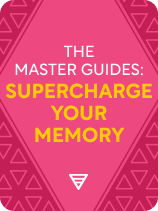

This article is an excerpt from the Shortform book guide to "The Master Guides: Supercharge Your Memory" by Shortform. Shortform has the world's best summaries and analyses of books you should be reading.
Like this article? Sign up for a free trial here.
How are memories formed in the brain? When creating new neural pathways, what factors influence how strong and lasting those memories will be?
Creating new neural pathways is the foundational part of how memories are formed in the brain. You can form stronger neural pathways by splitting your learning process into two steps: taking effective notes, and applying active learning strategies like spaced repetition, active recall, and teaching.
Read on to learn more about how to supercharge your memory and the two-step method for creating new neural pathways.
How Memories Are Formed in the Brain
Learning and memory experts suggest that the first step to supercharging your memory is to understand the pivotal role neural pathways play in your ability to recall and retain information. Several authors provide insights into creating new neural pathways, each detailing different aspects of how the brain commits information to memory.
Neurons form memory pathways: Experienced educator Barbara Oakley and neural network expert Terrence Sejnowski (Learning How to Learn), explain that when you think, brain cells called neurons make connections with each other, creating a neural pattern or pathway that represents the information in your brain. The connections between the neurons that make up this pathway are called synapses. The more synapses a certain idea activates in your brain, the better you’ll learn it, because it’s connected to more neurons, giving your brain more neural pathways it can use to retrieve it.
Strong neural pathways enhance memory: Building on this concept, in Learn Like a Pro, Oakley and learning expert Olav Schewe explain that when you learn something simple, like a phone number, those neural pathways are short. But when you learn something complex, the pathways grow longer and form webs of connections that cement what you learned into your long-term memory. The more you use neural pathways, the stronger the bonds between the neurons become, and the more ingrained the information becomes. This is why when you practice a skill, it becomes easier, or when you regularly review and recall information, you’re less likely to forget it. This is due to how memories are formed in the brain.
Memories intertwine in associative webs: Journalist and former winner of the US Memory Championships Joshua Foer (Moonwalking With Einstein) highlights that memories don’t exist in isolation; they’re stored in a web of associations. For example, thinking of the word “baker” would probably also make you think about bread or your favorite bakery. Therefore, to retrieve memories, you must search for pieces of information by thinking about other things that are connected to them in this neural web of associations. For example, to remember what your friend’s car looks like, think more generally about your friend or about cars in order to “search” the web of associations that will eventually lead you to the memory of your friend’s car. Creating new neural pathways in association with existing webs of information will make it easier for you to retrieve those memories in the future.
To sum up these aspects of memory, actively engaging with and reinforcing the information you want to memorize encourages your brain to form strong neural associations that supercharge your memory. In this article, we’ll explore ways of creating new neural pathways and strengthening neural associations in two parts:
- Step 1 explores note-taking techniques that take advantage of how memories are formed in the brain through association.
- Step 2 presents strategies for actively engaging with your notes to help solidify the information in your long-term memory.
Step 1: Creating New Neural Pathways by Taking Effective Notes
According to learning practitioners, taking effective notes is key to capturing and retaining new information. Let’s explore how to enhance your note-taking with three techniques that leverage your brain’s natural affinity for association: Clarify your note-taking goals, create multisensory associations, and take notes about your notes.
Technique #1: Clarify Your Note-Taking Goals
In Limitless, teacher, life coach, and motivational speaker Jim Kwik asserts that the first step in effective note-taking is to clarify what you’re interested in learning (or what you must learn) from the material you’re studying. In other words, identify your goal in studying that specific material and then take notes based on that goal. This approach will help you filter through the information you’re getting and look for what’s relevant to that goal.
Technique #2: Create Multisensory Associations
Experts agree that creating multisensory associations when taking notes can greatly boost their effectiveness as memory aids.
Foer suggests incorporating as many of your senses as you can into your mental representations of things you want to remember. He explains that the more senses you incorporate, the more cues you have to remind you of the memorized information. If applicable, imagine how something looks, smells, sounds, feels, and tastes.
The reason for this, as Oakley and Sejnowski explain, is that connecting an idea to inputs from more senses creates more synaptic connections in more neural pathways in your brain. This makes it easier to learn and remember because you are creating more new neural pathways your brain can use to retrieve the idea.
Technique #3: Take Notes About Your Notes
Oakley and Schewe suggest that actively engaging with your content—by taking notes about your notes—enhances the effectiveness of your note-taking. This involves:
Simplifying the information you’re working with: Think of easier words to describe the concept and focus on the main ideas rather than getting lost in the details. One way to do this is to use mind maps to organize your notes. Mind maps are visual representations of topics that typically start with a central idea or concept and branch into related ideas connected with lines, colors, and images. By visually organizing the material, mind maps help distill complex information into more digestible components, making it easier to identify and remember key points.
Step 2: Strengthening New Neural Pathways With Active Learning Strategies
Once you’ve taken notes, the next step is to actively engage with them to help solidify the information in your long-term memory. Oakley and Schewe explain that actively engaging with your learning materials helps you absorb far more information than when you passively engage with them. This is because active learning helps build longer and stronger neural connections.
Experts suggest three active learning strategies: Practice spaced repetition, test yourself with active recall, and teach what you’ve learned.
Technique #1: Practice Spaced Repetition
Your brain remembers information best by engaging with it repeatedly over time—this popular concept is called “spaced repetition.” The more time that passes after you learn something, the more information you forget. The key to overcoming this is to review the information again right before you’re about to forget it. Keep doing this each time you feel you’re close to forgetting the material. Each time you review it, you’ll be able to remember the information for longer, eventually fully ingraining it into your long-term memory.
Technique #2: Test Yourself With Active Recall
Kwik notes that many people try to learn new information by rote memorization: repeating something until it sticks. However, rote learning is ineffective because you’re basically trying to bully your brain into accepting the information. Given how memories are formed in the brain, active learning—actively participating in the learning experience—is much more effective (and enjoyable!) than rote memorization.
Rote memorization only commits the information you’re trying to memorize to your short-term memory, making it a waste of time in the long run. Instead, the most effective way to improve retention of new information is through retrieval practice, which is any exercise that requires you to recall what you’ve learned.
According to Oakley and Sejnowski, active recall (or retrieval practice) can take a variety of forms, depending on what you’re studying: If you’re memorizing facts, try to recite them or write them down from memory—don’t just reread them in your textbook or from your notes. If you’re learning a problem-solving technique, work through a problem with it—don’t just read an example solution. If you’re learning a hands-on skill, practice doing the work—don’t just watch someone else do it.
Technique #3: Teach What You’ve Learned
Kwik suggests that you should study what you want to memorize with the intent to teach it to somebody else—and to actually teach it to another person if possible.
(Shortform note: Studies show that teaching others can help you retain what you’ve learned. In one study, students who taught others didn’t do significantly better in the short term than those who only learned the material themselves; however, when tested again a week later, those who had taught the material to other students remembered a great deal more of it. This is attributed to the protégé effect, a psychological phenomenon that boosts metacognitive processes. Teaching, or even pretending to teach to others, involves testing your knowledge and using it to inform others. This makes you more aware of your level of understanding and which areas you might need to improve in.)

———End of Preview———
Like what you just read? Read the rest of the world's best book summary and analysis of Shortform's "The Master Guides: Supercharge Your Memory" at Shortform.
Here's what you'll find in our full The Master Guides: Supercharge Your Memory summary:
- Memory retention methods from a diverse group of experts
- Three techniques for enhancing your note-taking abilities
- Three active learning strategies to help you solidify your long-term memory






